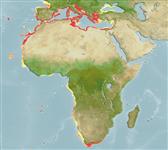>
Eupercaria/misc (Various families in series Eupercaria) >
Sparidae (Porgies)
Etymology: Diplodus: Greek, diploos = twice + Greek, odous = teeth (Ref. 45335).
Environment: milieu / climate zone / depth range / distribution range
البيئة
بحري قاعية التغذية و المعيشة; محيطية (Ref. 51243); نطاق العمق 0 - 160 m, usually 0 - 30 m (Ref. 13780). Subtropical; ? - 25°C (Ref. 130592); 50°N - 40°S, 26°W - 36°E
Eastern Atlantic: Bay of Biscay to Cape Verde and the Canary Islands including the Mediterranean and Black Sea (off Bulgaria); also from Angola to South Africa.
Length at first maturity / الحجم / وزن / العمر
Maturity: Lm 16.6 range ? - ? cm
Max length : 45.0 cm TL ذكر/ مختلط الجنس; (Ref. 3397); common length : 22.0 cm TL ذكر/ مختلط الجنس; (Ref. 3397); أعلا وزن تم نشرة: 1.3 kg (Ref. 40637)
A euryhaline species inhabiting rocky and sometimes sandy bottoms to depths of 160 m, but more commonly in less than 50 m. The young are sometimes found in seagrass beds. Adults feed on crustaceans, worms and mollusks (Ref. 3688). Important food fish.
Potentially hermaphroditic (Ref. 4781).
Bauchot, M.-L. and J.-C. Hureau, 1990. Sparidae. p. 790-812. In J.C. Quero, J.C. Hureau, C. Karrer, A. Post and L. Saldanha (eds.) Check-list of the fishes of the eastern tropical Atlantic (CLOFETA). JNICT, Lisbon; SEI, Paris; and UNESCO, Paris. Vol. 2. (Ref. 3688)
IUCN Red List Status (Ref. 130435: Version 2024-2)
استخدامات بشرية
مصائد: تجاري; لعبة سمكه: نعم; حوض مائي: تجاري
أدوات
تقارير خاصة
Download XML
مصادر علي الأنترنت
Estimates based on models
Preferred temperature (Ref.
123201): 15.9 - 21.6, mean 18.8 °C (based on 248 cells).
Phylogenetic diversity index (Ref.
82804): PD
50 = 0.5000 [Uniqueness, from 0.5 = low to 2.0 = high].
Bayesian length-weight: a=0.01230 (0.01098 - 0.01378), b=3.05 (3.03 - 3.07), in cm total length, based on LWR estimates for this species (Ref.
93245).
مستوى غذائي (Ref.
69278): 3.5 ±0.1 se; based on diet studies.
Generation time: 4.3 (2.8 - 5.5) years. Estimated as median ln(3)/K based on 16
growth studies.
المرونه (Ref.
120179): وسيط, الحد الزمني الأدني لتضاعف عدد أفراد المجتمع 1.4-4.4 سنة (K=0.26-0.4; tmax=6; tm=2).
Fishing Vulnerability (Ref.
59153): Low to moderate vulnerability (33 of 100).
Climate Vulnerability (Ref.
125649): Low vulnerability (23 of 100).
Nutrients (Ref.
124155): Calcium = 49.2 [25.2, 92.2] mg/100g; Iron = 0.766 [0.416, 1.387] mg/100g; Protein = 18.8 [17.8, 19.7] %; Omega3 = 0.345 [0.189, 0.641] g/100g; Selenium = 29.6 [13.1, 62.5] μg/100g; VitaminA = 24.3 [6.3, 92.6] μg/100g; Zinc = 0.919 [0.627, 1.322] mg/100g (wet weight); based on
nutrient studies.
